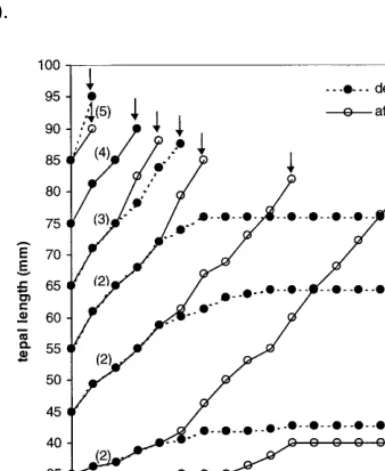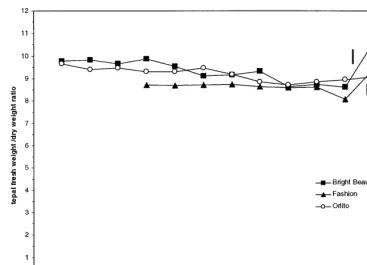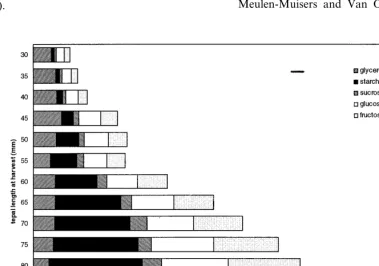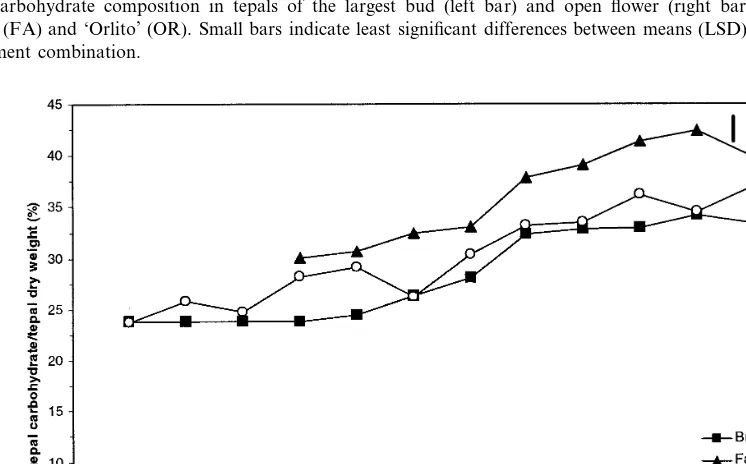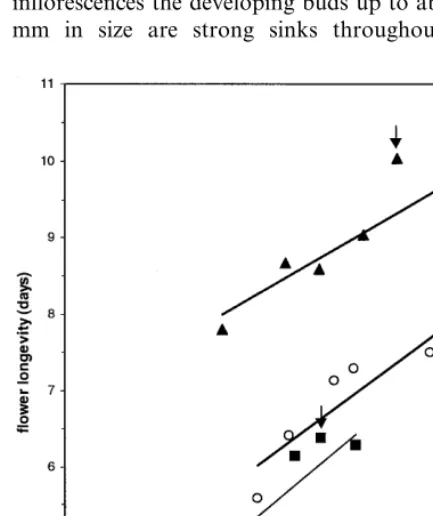Postharvest flower development in Asiatic hybrid lilies as
related to tepal carbohydrate status
Jose´ J.M. van der Meulen-Muisers
a, Joop C. van Oeveren
a,w,
Linus H.W. van der Plas
b, Jaap M. van Tuyl
a,*
aPlant Research International,P.O.Box16,6700AA Wageningen,The Netherlands
bDepartment of Plant Physiology,Wageningen Uni6ersity,Arboretumlaan4,6703BD Wageningen,The Netherlands Received 16 March 2000; accepted 17 July 2000
Abstract
For three Asiatic hybrid lily cultivars (‘Bright Beauty’, ‘Fashion’, ‘Orlito’) the potential postharvest performance of floral buds in terms of growth, anthesis and longevity was studied in relation to tepal carbohydrate status. To determine the importance of carbohydrate redistribution within lily inflorescences, the postharvest performance of several attached and detached buds was compared at the time of anthesis of the most mature floral bud of the inflorescence. Detachment of buds increased failure of opening in small buds, whereas in the largest buds tepal size at anthesis and longevity were improved. In lily inflorescences, postharvest translocation of substrate from the basal to the upper buds takes place. Five bud classes have been characterised, comparing the postharvest performance of attached and detached buds. Classes were based on differences in tepal growth rate, absolute growth and the potential to reach anthesis. A bud length of about 60 mm at harvest, appeared to be critical for reaching anthesis of detached buds. Comparable bud development and flower longevity of inflorescence-attached and inflorescence-detached floral buds was determined in buds of 70 – 75 mm. At this bud length the total carbohydrate content (fructose, glucose, glycerol glucoside, starch, sucrose) covered about three-fourths of the total tepal carbohydrate content found in the largest bud stage just prior to anthesis. Per cultivar, postharvest flower longevity after anthesis of detached buds was well correlated with total carbohydrate content of the tepals at harvest. Longevity of inflorescence-attached flowers remained constant within the inflorescence, likely due to postharvest redistribution of tepal carbohydrate. These findings indicate an important role for tepal carbohydrate content in postharvest bud development and flower longevity of Asiatic hybrid lilies. Carbohydrate redistribution is suggested to play a major role in the postharvest performance of Asiatic lily inflorescences. © 2001 Elsevier Science B.V. All rights reserved.
Keywords:LiliumL.; Anthesis; Bud development; Carbohydrate; Flower longevity; Inflorescence
www.elsevier.com/locate/postharvbio
* Corresponding author. Tel.: +31-317-477001; fax: +31-317-418094. E-mail address:[email protected] (J.M. van Tuyl). w21 May 1997.
1. Introduction
Unlike most other horticultural crops, cut flow-ers are often harvested before full development. Particularly in case of inflorescence-type flowers, which consist of several buds differing in the stages of development, a large part of the floral buds is usually still in a premature developmental stage at harvest.
The formation of a mature flower depends on carbohydrate supply. Before harvest, inflores-cences are supplied with carbohydrates by photo-synthesis, which occurs in the green organs of the plant. After reaching the inflorescence these as-similates are distributed among the various floral buds. The proportion of assimilate uptake in each bud is correlated with the organ sink strength, which largely depends on the rate of utilisation of imported assimilates in the sink tissue (Ho, 1988). Postharvest light intensity is usually low and, therefore, the production of carbohydrates by photosynthesis of cut flowers generally is negligi-ble. Since the amount of carbohydrate in cut flowers is limited, competition for carbohydrate among developing buds within the inflorescence may occur. A deficiency in carbohydrate reserve in the inflorescence may result in the failure of bud opening, starting in the smallest bud stages as is hypothesised to take place in inflorescence-type bulbous species like freesia (Spikman, 1989) and
Gladiolus (Serek et al., 1994). Therefore, under-standing carbohydrate metabolism in the flower requires that the development of the surrounding floral buds in the inflorescence is taken into ac-count in terms of competition for carbohydrate import.
In Lilium, flower buds express a high sink
strength throughout their development until an-thesis (Wang and Breen, 1986), probably corre-lated with the increase in growth of floral tissue, occurring after the anthers have reached the spo-ral mitosis stage (Cle´ment et al., 1996). Variation in individual flower longevity within the lily infl-orescence is relatively small despite large differ-ences in developmental stage of the floral buds at harvest (Van der Meulen-Muisers and Van Oev-eren, 1996; Van der Meulen-Muisers et al., 1998). In a previous paper, it was demonstrated that
preharvest floral bud reduction increases individ-ual flower longevity in Lilium after harvest (Van der Meulen-Muisers et al., 1995). The effects of preharvest floral bud reduction on flower longevity were probably mainly due to a reduc-tion of the number of competitive sinks within the inflorescence after harvest. The role of carbohy-drate redistribution in postharvest development of lily flowers might, therefore, be important.
The purpose of the present paper is to study flower carbohydrate metabolism during posthar-vest floral bud development by quantifying the development of the tepals and to correlate the results with their carbohydrate content. First the potential postharvest floral bud development was studied, and next, soluble and insoluble tepal sugar contents were assayed at several stages of bud development. Ultimately, we attempted to determine the importance of carbohydrate redis-tribution in relation to flower development by comparing the postharvest performance of infl-orescence-attached buds and inflorescence-de-tached buds. To affirm our hypothesis about the importance of carbohydrate redistribution in infl-orescence-type cut flowers, we focussed on the postharvest flower development of three lily culti-vars differing in individual flower longevity.
2. Materials and methods
Bulbs of Asiatic lily hybrids (LiliumL.), 12 – 16 cm in circumference, were obtained from commer-cial growers in The Netherlands and from the lily collection of Plant Research International. Three cultivars, ‘Bright Beauty’, ‘Fashion’, and ‘Orlito’ were used. The choice of the cultivars is based on known differences in individual flower longevity (Van der Meulen-Muisers et al., 1998). Before planting, the bulbs were stored in moist peat at
−2°C for about 8 months.
photosynthetic photon flux density (PPFD) of about 112 mmol m−2 s−1 using high pressure
metal halide lamps (HPI-T 400W, Philips). Inflorescences were harvested at anthesis of the most mature floral bud by cutting the stems at the soil level within 4 h after the onset of the pho-toperiod. Tepal length was measured and subse-quently, the buds were divided into groups differing by 5 mm increments in length. In addi-tion, open flowers were included. When tepals were to be studied, they were excised from the inner whorl of the flower head at harvest.
Cut inflorescences and cut individual buds were both placed in glass flasks containing tap water, and were held at 17°C, 60% RH, and a 12 h photoperiod. PAR was kept at a PPFD of about 14 mmol m−2 s−1 using fluorescent lamps
(TL-D84 36 W, Philips).
Tepal length of both the inflorescence-attached and inflorescence-detached floral buds was recorded until anthesis, as a parameter for tepal growth. From each available developmental stage at harvest eight flowers were studied. Flower longevity was recorded as the time between anthe-sis and visual withering of the tepals. Each indi-vidual floral bud and flower was observed daily within 4 – 6 h after the onset of the photoperiod.
From each available developmental stage at harvest, 12 flowers were sampled. One tepal (inner whorl) of each flower was weighed to determine tepal fresh weight, immersed in liquid nitrogen, freeze-dried and reweighed to determine tepal dry weight. Fresh weight/dry weight ratios were calculated.
From the 12 samples per developmental stage four replicates were composed by pooling the freeze-dried tepals of three different flowers before grinding. Using 10 mg of the powder, sugars were extracted in 80% methanol (76°C) for 15 min. Before extraction raffinose was added to the 80% methanol as the internal standard. After centrifu-gation the pellet was stored for starch analysis. The supernatant was vacuum-evaporated and its residue was taken up in 1 ml purified water (Milli-Q purification system, Millipore, Molsheim, France). After proper dilution the samples were injected in a Dionex HPLC system (Dionex Cor-poration, Sunnyvale, CA). The HPLC was
equipped with a CarboPac PA1 column and a pulsed-amperometric detection system with an Au working electrode and an Ag/AgCl reference elec-trode. Peaks were identified by comparing their retention times with the retention times of a mix-ture of standard sugars (De Bruijn et al., 1997). A peak that eluted before glucose has been identified as glycerol glucoside, and could be quantified by using the response factor of glucose after dividing it by 1.5 (U. Van Meeteren and A.C. Van de Peppel, pers. commun.). Total soluble carbohy-drate was calculated by summing glucose, fruc-tose, sucrose and glycerol glucoside.
Preliminary analysis ascertained that Asiatic lily tepal tissue did not contain any fructans, and that the storage carbohydrate in the developing floral buds was starch. Starch determination was per-formed on the tissue pellet that remained after soluble carbohydrate extraction, using a commer-cial starch determination kit (Boehringer, Mannheim, Germany) according to the protocol of the supplier.
Completely randomised designs were used. Data were analysed by analysis of variance, using the Genstat 5 statistical package (Rothamsted, UK). Correlation coefficients of linear regression (r) were calculated to look for associations be-tween tepal carbohydrate content and flower longevity.
3. Results
3.1. Bud growth
Postharvest growth of attached and detached buds was similar for the three cultivars tested, and is demonstrated for ‘Orlito’ in Fig. 1. In buds reaching anthesis postharvest bud growth pro-ceeded nearly linear in time. In buds that failed to open, postharvest bud growth was halted prema-turely. In both attached and detached buds, tepal length at anthesis slightly decreased with develop-mental stage at harvest. At anthesis, the tepal length exceeded 75 mm in all the three cultivars tested.
within the inflorescences varied per cultivar, with a minimal length of 30 mm (‘Bright Beauty’, ‘Orlito’) or 45 mm (‘Fashion’) and a maximal tepal length in the open flower of 85 mm (‘Bright Beauty’, ‘Fashion’) or 90 mm (‘Orlito’). The study of the postharvest development of detached and attached flower buds made it possible to deter-mine five classes. Classes were based on differ-ences in the tepal growth rate, absolute growth and the potential to reach anthesis (Fig. 1, Table 1).
All the attached buds reached anthesis, except for buds of class 1. After detachment both buds of class 1 and 2 did not complete their develop-ment. Within buds of class 2 the growth rate of the tepals in detached buds was lower than the growth rate of attached buds, from three (‘Bright Beauty’) or four (‘Fashion’, ‘Orlito’) days after harvest. Of the detached buds reaching anthesis (class 3 – 5) only buds of class 4 completed their development in the same way as matching at-tached buds. Within class 3 anthesis occurred later in time, whereas in class 5 the tepals of the resulting flowers were larger in size. In class 3 the growth rate of the tepals of detached buds was lower compared with the growth rate of the tepals of attached buds, from two days after harvest independent of the cultivar tested (Fig. 1, e.g. ‘Orlito’).
3.2. Anthesis
In ‘Fashion’ and ‘Orlito’, respectively, 100 and 96% anthesis was obtained in attached flowers, whereas in attached flowers of ‘Bright Beauty’ 81% of the floral buds reached anthesis. After detachment, the percentage of floral buds that reached anthesis decreased 20 (‘Fashion’) to 48% (‘Orlito’), (data not shown). For all three cultivars tested, a bud length of about 60 mm at harvest appeared to be critical for reaching anthesis for a bud detached from the inflorescence (Table 1).
3.3. Flower longe6ity
Longevity of attached flowers remained nearly constant within the inflorescence independent of the developmental stage of the floral bud at har-vest. After anthesis, longevity of detached flowers increased with the progression of the stage of development at harvest (Fig. 2). Longevities of the two largest bud stages and of the open flower were significantly improved (P=0.05) in detached flowers compared with those of attached flowers in all three cultivars (Fig. 2). Detaching open flowers at harvest improved their longevity by about 14 – 18% depending on the cultivar. Fig. 1. Postharvest development of inflorescence-attached
Table 1
Distribution of five classes of flower buds (as defined in Fig. 1) and open flowers at harvest (OF), within lily inflorescences of ‘Bright Beauty’, ‘Fashion’ and ‘Orlito’; classes were distinguished comparing the postharvest development of attached lily flower buds with detached buds of initially the same tepal length at harvest of the inflorescence
Genotype Class number
Tepal length of floral buds at harvest (mm)
35 40 45
30 50 55 60 65 70 75 80 85 90
1 1 2 2 2 2/3
‘Bright Beauty’ 1 3 4 4 5 OF .a
. . 2 2 2 2/3 3 4 5 5 OF
‘Fashion’ . .
2 2 2 2 2 2/3 3 3 4 5
1 5
‘Orlito’ OF
a., Tepal length not present at harvest of the inflorescence.
3.4. Tepal weight
Tepal fresh weight and dry weight increased almost proportionally with tepal length until the largest bud stage before anthesis. As a conse-quence, the tepal fresh weight/dry weight (fw/dw) ratio remained almost constant within the infl-orescence (Fig. 3). Maximum fresh weight oc-curred in tepals of fully opened flowers in all the three cultivars tested. Maximum dry weight oc-curred at anthesis (‘Orlito’) or at the largest bud stage just before anthesis (‘Bright Beauty’, ‘Fash-ion’) (data not shown). Between the largest floral bud before anthesis and the open flower (a 24 h time lapse in development) an increase in the fw/dw ratio occurred (Fig. 3). Tepal fw/dw ratios were similar for the three cultivars tested (Fig. 3).
3.5. Tepal carbohydrate
The total carbohydrate content (soluble carbo-hydrate and starch) of lily tepals gradually in-creased with the developmental stage of the floral buds (Fig. 4, e.g. ‘Orlito’). Glycerol glucoside was the major tepal carbohydrate in the smaller bud stages up to about 55 mm; it remained constant or slightly decreased through all the stages of bud development. From a bud length of about 55 mm, starch became the major tepal carbohydrate. Tepal starch content increased with bud develop-ment to a maximum value at the largest bud stage before anthesis and then declined to low levels at bud opening. Amounts of glucose and fructose
were nearly identical through all stages of bud development, and gradually increased with the developmental stage of the floral buds. When
Fig. 3. Tepal fw/dw ratio of flower buds of ‘Bright Beauty’, ‘Fashion’ and ‘Orlito’ at the stages of development present at the time of anthesis of the most mature flower bud. Developmental stages are defined by the tepal length of the flower buds (in mm). Arrows indicate open flowers. Bars indicate least significant differences between means (LSD) atP=0.05; n=12 flowers per treatment combination.
starch content declined near anthesis, glucose and fructose content rapidly increased in ‘Orlito’ (Figs. 4 and 5). In ‘Bright Beauty’ and ‘Fashion’, the increase in glucose and fructose with the decrease of starch at bud opening was less pro-found, since total tepal carbohydrate content de-creased (Fig. 5). Tepal sucrose content gradually increased with bud development, but remained at relatively low values (about 7% of the total tepal carbohydrate) for all the bud stages, with an increase to 12 – 15% in the open flower (Figs. 4 and 5).
3.6. Flower de6elopment as related to tepal
carbohydrate content
At a bud length of about 60 mm, the critical stage of detached buds to reach anthesis (Table 1), the total carbohydrate content (soluble sugar
and starch) amounted to 12 (‘Bright Beauty’) to 14 mg (‘Fashion’) per tepal. At this bud length there was also a colour change from greenish to the true flower colour in each cultivar (data not shown). At a bud length of 70 mm (‘Bright Beauty’, ‘Fashion’) or 75 mm (‘Orlito’), attached and detached buds showed a similar growth pat-tern towards anthesis and a comparable final tepal length (Table 1, group 4). After anthesis of those buds, longevities of attached and detached flowers were non-significantly different (Fig. 2). At this bud length total tepal carbohydrate con-tent amounted to 21 – 25 mg, covering 68 (‘Fash-ion’) to 78% (‘Bright Beauty’) of the total tepal carbohydrate content found in the largest bud stage just prior to anthesis.
Be-tween the largest bud stage and the open flower the percentage of total tepal carbohydrate in-creased in ‘Orlito’, and slightly dein-creased in ‘Bright Beauty’ and ‘Fashion’ (Fig. 6). At anthe-sis, carbohydrates accounted for 33 – 41% of the tepal dry weight depending on the cultivar (Fig. 6).
Flower longevity of detached buds that reached anthesis was positively correlated with the total carbohydrate content of the tepals at detachment, for all three cultivars tested (Fig. 7). For all the cultivars taken together, the association was moderately high (r=0.62). No association was found between longevity of the attached flowers and total carbohydrate content of the tepals at the stage the inflorescence was harvested, as flower longevity of attached flowers hardly changed within the inflorescence (Fig. 2).
4. Discussion
The postharvest development of attached lily floral buds follows a clearly defined pattern that hardly changes with the position of the bud on the stem as illustrated for ‘Orlito’ in Fig. 1. Lily flower maturation is characterised by an increase in bud size (tepal length Fig. 1, fresh weight and dry weight), and a change in the pigmentation of the tepals (data not shown). Soluble carbohydrate levels and starch increase until anthesis (Fig. 4, e.g. ‘Orlito’). At anthesis, tepal starch shows a decrease with a subsequent increase in the soluble carbohydrate levels (Fig. 5) and an increase in water content leading to an increase in the fw/dw ratio (Fig. 3). Within inflorescences harvested at anthesis of the most mature floral bud nearly all buds reach anthesis, as reported before (Van der Meulen-Muisers and Van Oeveren, 1997). After
Fig. 5. Carbohydrate composition in tepals of the largest bud (left bar) and open flower (right bar) of ‘Bright Beauty’ (BR), ‘Fashion’ (FA) and ‘Orlito’ (OR). Small bars indicate least significant differences between means (LSD) atP=0.05;n=4 samples per treatment combination.
anthesis, postharvest senescence of the attached lily flowers hardly changes with the position of the flower on the stem resulting in a constant longevity level within the inflorescence (Fig. 2).
Data on detached floral buds showed that pre-venting translocation of metabolites within the inflorescence altered the pattern of postharvest maturation (Fig. 1, e.g. ‘Orlito’) and senescence (Fig. 2) in nearly all the buds. Detachment in-creased failure of bud opening compared with attached buds from the smallest bud sizes up to a size of about 60 mm. At the same time, in the largest bud stages tepal size at anthesis (Fig. 1, e.g. ‘Orlito’) and longevity (Fig. 2) improved in the detached flowers as compared to the attached flowers. These results suggest that within cut lily inflorescences the developing buds up to about 60 mm in size are strong sinks throughout their
growth. The demands of those sinks are, at least partially, accounted for by translocation of metabolites from the larger flower buds (and open flower) reducing their tepal length at anthesis and/or their longevity. However, the smallest buds sizes in ‘Bright Beauty’ (30 – 40 mm) and to a lesser extent in ‘Orlito’ (30 mm) appeared to be weak sinks. Their growth was minimal when at-tached to the inflorescence and they failed to open (Table 1, class 1). Their sink strength might be insufficient to compete with the other developing buds for substrate provided by the open flower and the largest bud stages within the inflores-cence. In ‘Fashion’ no such small buds were present at harvest (Table 1), mainly due to culti-var differences in flower bud distribution as re-ported before (Van der Meulen-Muisers and Van Oeveren, 1996). For buds up to 60 mm, develop-mental differences between attached and detached flower buds became visible about 3 – 4 days after harvest (Fig. 1, e.g. ‘Orlito’). Within the inflores-cence, translocation of substrate from the basal to the upper buds apparently starts near this point of time.
The stage of maturity of the buds is marked by the content of carbohydrate of the tepals, more mature buds containing more tepal carbohydrate (Fig. 4, e.g. ‘Orlito’). Failure of bud opening in lily could be due to the lack of carbohydrate as discussed in other inflorescence-type bulbous spe-cies such as freesia (Spikman, 1989) and Gladiolus
(Serek et al., 1994). In lily, failure of bud opening is known to increase when inflorescences are har-vested in a less mature stage (Van der Meulen-Muisers and Van Oeveren, 1997). From the data presented above, it can be concluded that harvest-ing inflorescences at a less mature stage will con-siderably reduce the carbohydrate content available for redistribution from the larger to the smaller buds.
In buds of 70 mm (‘Bright Beauty’, ‘Fashion’) or 75 mm (‘Orlito’), with a tepal carbohydrate content of 21 – 25 mg, comparable bud develop-ment and flower longevity of attached and de-tached floral buds was determined (Table 1 [class 4], Figs. 1 and 2). Those carbohydrate amounts cover 68 (‘Fashion’) to 78% (‘Bright Beauty’) of the total tepal carbohydrate content found in the Fig. 7. Relationship between longevity of ‘Bright Beauty’,
largest bud stage just prior to anthesis, indicating a carbohydrate surplus in tepals of the most ma-ture floral bud stages and in tepals of the open flower. In attached floral buds at least part of the carbohydrate surplus will likely be available for redistribution to smaller buds. As discussed above, redistribution will lead to an increase in the number of buds that will reach anthesis (Table 1, Fig. 1, e.g. ‘Orlito’), comparing attached and detached floral buds. At the same time, longevity of the flowers obtained from the largest bud sizes and of the open flower at harvest will decrease in attached flowers compared to detached flowers (Fig. 2). The relatively smallest carbohydrate sur-plus (22%) was found in tepals of the cultivar with the shortest flower longevity (‘Bright Beauty’), and the relatively largest carbohydrate surplus (32%) was found in tepals of the cultivar with the longest flower longevity (‘Fashion’). This could be an important factor in the search for an explana-tion of the existence of cultivar differences in flower longevity.
The gradual increase of the total carbohydrate/
dry weight ratio with developmental stage of the buds indicates carbohydrate filling of the tepals as they develop (Fig. 6). Near anthesis total tepal carbohydrate in percentage of dry-weight ap-peared to amount to 33 – 41%, comparable with the value that can be derived from data onGladi
-olusflowers (Yamane et al., 1993). Anthesis after detachment of floral buds appeared to be depen-dent on the stage of maturity of the buds at harvest. To obtain anthesis, a bud length of about 60 mm, concomitant with 12 – 14 mg carbohydrate content per tepal, appeared to be critical (Table 1, Fig. 4, e.g. ‘Orlito’).
Reducing sugars appeared to form a large pro-portion of the carbohydrate pool in the tepals (Figs. 4 and 5). This supports the view that the floral buds are active metabolic centres, since the translocation sugar is probably sucrose. The nearly identical amounts of fructose and glucose within lily tepals (Figs. 4 and 5) suggest that sucrose is probably rapidly converted by invertase at its site of accumulation, a characteristic which is specific for sink organs (Avigad, 1982).
Anthesis appeared to be accompanied by hy-drolysis of starch leading to an increase in the
sugar content (Fig. 5). Similar interactions be-tween starch and sugar content have been re-ported during the expansion of rose petals (Evans and Reid, 1988) and Alstroemeria petals (Collier, 1997). Besides supplying substrate for respiratory processes, starch hydrolysis especially provides os-motic solutes for water influx and cellular expan-sion. The tepal fw/dw ratio, an indirect measure of the proportion of dry weight that consists of osmotically active solutes (Evans and Reid, 1988), increased at anthesis (Fig. 3). This shows that part of the tepal expansion was due to an increased water uptake.
The increase in sugar content near anthesis did not quantitatively correspond with the disappear-ance of starch (Fig. 5). Within ‘Orlito’ the total tepal carbohydrate content increased, whereas in ‘Bright Beauty’ and ‘Fashion’ it decreased at the time of starch hydrolysis. These data suggest that at anthesis both net-import and net-export of carbohydrates can take place in lily tepals, de-pending on the cultivar.
Tepals of developing lily buds contained, in addition to glucose, fructose, sucrose and starch, glycerol glucoside (Figs. 4 and 5). Glycerol glu-cosides seem to be characteristic constituents of the genus Lilium and their structures have been reported to vary depending on the species (Kaneda et al., 1974, 1982, 1984). The glycerol glucoside detected in our study could be lilioside C, isolated from Lilium tigrinum(syn. Lilium lan
-cifolium) (Kaneda et al., 1982) one of the ances-tors of the Asiatic hybrids. Tepal glycerol glucoside was especially a dominant component at the youngest bud stages, while its content hardly changed at the developmental stage of the floral buds. Glycerol glucoside is, therefore, not likely to play an important role in the carbohydrate metabolism of lily flowers.
association (r=0.62) between flower longevity and tepal carbohydrate was found using the unified data of all three cultivars. Apparently besides tepal carbohydrate content also other fac-tors account for cultivar differences in lily flower longevity.
Asiatic lily inflorescences offer an interesting model system for studies on postharvest flower development, because individual flowers provide a graded series of stages of development in an iden-tical genetic and environmental background. Fur-thermore, cultivars differing in flower longevity correspond in a similar way. A dominant role of tepal carbohydrate content in bud development and flower longevity of Asiatic lilies can be pro-posed from the findings of the present study. Further studies on factors such as carbohydrate degradation and redistribution in lily flowers and inflorescences are needed for a better understand-ing of cultivar differences in the relationship be-tween carbohydrates and longevity of Asiatic hybrid lilies.
Acknowledgements
The authors are grateful to S.M. De Bruijn, J.R. Mouris and G.P. Terwoert for technical as-sistance, J. Jansen for statistical advice, and F.A. Hoekstra for constructive discussions and critical reading of the manuscript. This work was finan-cially supported by the Urgency Programme for Research on Diseases and Breeding of Flower Bulbs.
References
Avigad, G., 1982. Sucrose and other disaccharides. In: Loewus, F.A., Tanner, W. (Eds.), Encyclopedia of Plant Physiology New Series, 13A. Springer, New York, pp. 217 – 347.
Cle´ment, C., Burrus, M., Audran, J.C., 1996. Floral organ growth and carbohydrate content during pollen develop-mentin Lilium. Am. J. Bot. 83, 459 – 469.
Collier, D.E., 1997. Changes in respiration, protein and
carbo-hydrates of tulip tepals and Alstroemeria petals during development. J. Plant Physiol. 150, 446 – 451.
De Bruijn, S.M., Ooms, J.J.J., Karssen, C.M., Vreugdenhil, D., 1997. Effects of abscisic acid on reserve deposition in developing Arabidopsis seeds. Acta Bot. Neerl. 46, 263 – 277.
Evans, R.Y., Reid, M.S., 1988. Changes in carbohydrates and osmotic potential during rhythmic expansion of rose petals. J. Am. Soc. Hortic. Sci. 113, 884 – 888.
Ho, L.C., 1988. Metabolism and compartmentation of im-ported sugars in sink organs in relation to sink strength. Annu. Rev. Plant Physiol. Plant Mol. Biol. 39, 355 – 378. Kaneda, M., Mizutani, K., Takahashi, Y., Kurono, G.,
Nishikawa, Y., 1974. Lilioside A and B, two new glycerol glucosides isolated fromLilium longiflorumThunb. Tetra-hedron Lett. 45, 3937 – 3940.
Kaneda, M., Mizutani, K., Tanaka, K., 1982. Lilioside C, a glucerol glucoside fromLilium lancifolium. Phytochemistry 21, 891 – 893.
Kaneda, M., Kobayashi, K., Nishida, K., Katsuta, S., 1984. Liliosides D and E, two glycerol glucosides fromLilium japonicum. Phytochemistry 23, 795 – 798.
Serek, M., Jones, R.B., Reid, M.S., 1994. Role of ethylene in opening and senescence of Gladiolus sp. flowers. J. Am. Soc. Hortic. Sci. 119, 1014 – 1019.
Spikman, G., 1989. Development and ethylene production of buds and florets of cut freesia inflorescences as influenced by silver thiosulphate, aminoethoxyvinylglucine and su-crose. Sci. Hortic. 39, 73 – 81.
Van der Meulen-Muisers, J.J.M., Van Oeveren, J.C., 1996. Influence of variation in plant characteristics caused by bulb weight on inflorescence and individual flower longevity of Asiatic hybrid lilies after harvest. J. Am. Soc. Hortic. Sci. 121, 33 – 36.
Van der Meulen-Muisers, J.J.M., Van Oeveren, J.C., 1997. Influence of bulb stock origin, inflorescence harvest stage and postharvest evaluation conditions of cut flower longevity of Asiatic hybrid lilies. J. Am. Soc. Hortic. Sci. 122, 368 – 372.
Van der Meulen-Muisers, J.J.M., Van Oeveren, J.C., Mei-jkamp, B.B., Derks, F.H.M., 1995. Effect of floral bud reduction on individual flower longevity in Asiatic hybrid lilies. Acta Hortic. 405, 46 – 57.
Van der Meulen-Muisers, J.J.M., Van Oeveren, J.C., Jansen, J., Van Tuyl, J.M., 1998. Genotypic variation in posthar-vest flower longevity of Asiatic hybrid lilies. J. Am. Soc. Hortic. Sci. 123, 283 – 287.
Wang, Y.T., Breen, P.J., 1986. Partitioning of 14C-assimilate in Easter Lily as affected by growth stage and flower removal. Sci. Hortic. 29, 273 – 281.
Yamane, K., Abiru, S., Fujishige, N., Sakiyama, R., Ogata, R., 1993. Export of soluble sugars and increase in mem-brane permeability ofGladiolusflorets during senescence. J. Jap. Soc. Hortic. Sci. 62, 575 – 580.
